
- •Главная
- •1.1 Напряжений и концентраторы
- •1.1.3 Концентраторы напряжения
- •1.3 Stress concentration factor
- •1.7 Elastic-plastic stress concentration
- •1.8 Joints: bolts and welds
- •3. Механические свойства конструкционных материалов
- •3.1 Напряженности испытания
- •3.2 Stress - strain diagram
- •3.3 Testing schemes
- •3.4 Strength
- •4 Прочность материалов
- •4.1 Tension and compression
- •4.2 Shear and torsion
- •4.3 Stress-strain state
- •4.4 Bending: force and moment diagrams
- •4.5 Geometrical characteristics of sections
- •4.6 Bending: stress and deformation
- •4.7 Mixed mode loading
- •4.8 Buckling
- •4.9 Statically indeterminate systems
- •4.10 Three-dimensional structures
- •References
- •5. Theory of elasticity
- •5.1 Deformation
- •5.2 Stress
- •5.3 Hooke's law
- •5.4 Plane problems
- •5.5 Torsion
- •5.6 Bending
- •5.7 Polar coordinates
- •5.8 Plates
- •5.9 Shells
- •5.10 Contact stresses
- •6.2 Distribution functions
- •6.3 Structural models of reliability
- •6.4 Limiting state
- •6.5 Dispersion
- •6.6 Durabilty
- •6.7 Design by reliability criterion
- •6.8 Risk
- •6.9 Safety classes
- •6.10 Risk : structural and social
- •References
- •7 Materials science
- •7.1 Crystalline solids
- •7.2 Mechanical properties
- •7.3 Failure
- •7.4 Phase diagrams
- •7.5 Heat treatment of metals and alloys
- •7.6 Corrosion of metals and alloys
- •7.7 Casting
- •7.8 Polymers
- •7.9 Composites
- •7.10 Forming of metals
- •8.2 Mechanical properties
- •8.3 Stress concentration
- •8.4 Defects
- •8.5 Residual Stress
- •8.6 Strength
- •8.7 Fatigue strength
- •8.8 Fracture
- •8.9 Weldability
- •References
- •9 Composites
- •9.1 Structure of composites
- •9.2 Fibers
- •9.3 Rigidity
- •9.4 Strength
- •9.5 Crack resistance
- •9.6 Optimization
- •9.7 Fatigue and temperature effect
- •9.8 Reliability
- •9.9 Joints
- •9.10 Material selection
- •References
- •10 Finite element analysis
- •10.1 Finite element method
- •10.2 Finite elements
- •10.3 Meshing
- •10.4 Boundary conditions
- •10.5 Deformation
- •10.6 Accuracy
- •10.7 Heat transfer analysis
- •10.8 Dynamics
- •10.9 Computational fluid dynamics
- •10.10 Design analysis
- •References
4.6 Bending: stress and deformation
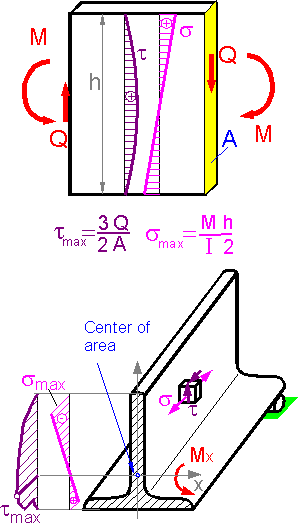 Tensile
bending stress is at a maximum in the outer layers of the beam. The
smaller the moment of inertia Ixx,
the larger the maximum bending stress. Shear stress is equal to zero
at the outer layers. It is at a maximum on the neutral axis of the
beam. Tensile bending stress is equal to zero at the neutral
axis.
Tensile
bending stress is at a maximum in the outer layers of the beam. The
smaller the moment of inertia Ixx,
the larger the maximum bending stress. Shear stress is equal to zero
at the outer layers. It is at a maximum on the neutral axis of the
beam. Tensile bending stress is equal to zero at the neutral
axis.
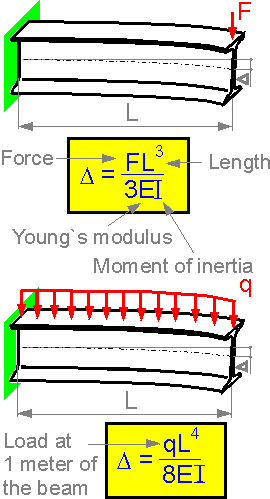 The
deflection is proportional to force and length3.
This means that a doubled length increase deflection by 8 times.
For a distributed load the order for length is
higher.
The
deflection is proportional to force and length3.
This means that a doubled length increase deflection by 8 times.
For a distributed load the order for length is
higher.
 Deflection
and rotation in the center can affect deflection of the right end of
the cantilever beam.
Heating of the upper flange of the
cantilever beam causes thermal expansion of upper layers and changes
the beam shape.
Deflection
and rotation in the center can affect deflection of the right end of
the cantilever beam.
Heating of the upper flange of the
cantilever beam causes thermal expansion of upper layers and changes
the beam shape.
 The
shape of the flexible beam depends on the external moments at the
beam ends Mi
= Fi
hi.
The
shape of the flexible beam depends on the external moments at the
beam ends Mi
= Fi
hi.
4.7 Mixed mode loading
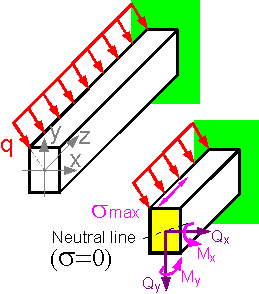 If
an external force passes through the center of the cross-section for
the shown scheme there is no torque Mz=0
and no projection of inner forces at axis z: Pz=0.
Upper
layers of the cantilever beam are under tension and lower layers are
under compression. If forces don't lie in a plane with a principle
axis, the neutral axis swings through some angle. The stress is
highest in points that are furthest from the shown neutral axis. The
top left point of the section has the maximum tensile stress.
If
an external force passes through the center of the cross-section for
the shown scheme there is no torque Mz=0
and no projection of inner forces at axis z: Pz=0.
Upper
layers of the cantilever beam are under tension and lower layers are
under compression. If forces don't lie in a plane with a principle
axis, the neutral axis swings through some angle. The stress is
highest in points that are furthest from the shown neutral axis. The
top left point of the section has the maximum tensile stress.
 The
summed stress pattern can be obtained by considering the tension and
bending of the beam. For long cantilever beams bending stress is
usually higher than tensile stress if both forces are equal.
The
summed stress pattern can be obtained by considering the tension and
bending of the beam. For long cantilever beams bending stress is
usually higher than tensile stress if both forces are equal.
 If
a compressive force was applied outside the center of the
cross-section, a tensile bending stress may occur. There is an area
in which the addition of a compressive force does not cause tensile
stress in the column. The shape of the zone for cylindrical sections
is a circle.
If
a compressive force was applied outside the center of the
cross-section, a tensile bending stress may occur. There is an area
in which the addition of a compressive force does not cause tensile
stress in the column. The shape of the zone for cylindrical sections
is a circle.
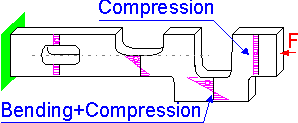 If
the line of force application and the center of the cross section do
not coincide by a distance h, there is bending moment F*h that causes
compressive and tensile stresses.
If
the line of force application and the center of the cross section do
not coincide by a distance h, there is bending moment F*h that causes
compressive and tensile stresses.
 Additional
bending moments cause a change in the shape. The shape depends on the
sign of the bending moment, positive or negative.
Additional
bending moments cause a change in the shape. The shape depends on the
sign of the bending moment, positive or negative.
 The
principle stress is at a maximum in the embedded end of the
structure, where torque T and bending moment M are highest.
The
principle stress is at a maximum in the embedded end of the
structure, where torque T and bending moment M are highest.
 Force
and moment diagrams for a complex structure can be obtained by the
static equilibrium conditions. Maximum number of inner forces and
moments is 6. There are geometries where less than 6 components of
inner forces and moments act.
Force
and moment diagrams for a complex structure can be obtained by the
static equilibrium conditions. Maximum number of inner forces and
moments is 6. There are geometries where less than 6 components of
inner forces and moments act.
4.8 Buckling
 In
1757, Leonard Euler proposed a relationship for the critical load
that would produce buckling in a pinned-pinned column. For other
supporting schemes (fixed-pinned, fixed-fixed, fixed-free, etc.)
engineers use an effective length Le
= k*L where k is the effective length constant.
In
1757, Leonard Euler proposed a relationship for the critical load
that would produce buckling in a pinned-pinned column. For other
supporting schemes (fixed-pinned, fixed-fixed, fixed-free, etc.)
engineers use an effective length Le
= k*L where k is the effective length constant.
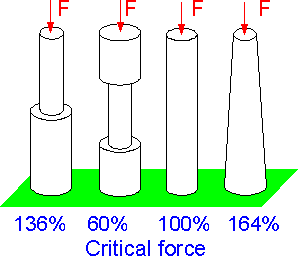 The
numbers show percents of critical buckling force for each column in
comparison with the uniform column. The last case demonstrates the
most efficient use of the material.
The
numbers show percents of critical buckling force for each column in
comparison with the uniform column. The last case demonstrates the
most efficient use of the material.
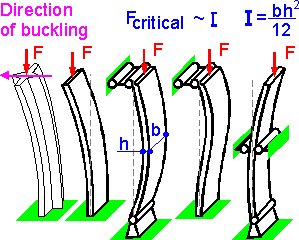 There
are two extreme directions with maximum and minimum values of the
moment of inertia. The buckling occurs in the direction of the
minimum moment of inertia.
For a rectangular section
buckling occurs perpendicular to the longer side. The resulting
deformed shape of the column depends on how the column is
supported.
There
are two extreme directions with maximum and minimum values of the
moment of inertia. The buckling occurs in the direction of the
minimum moment of inertia.
For a rectangular section
buckling occurs perpendicular to the longer side. The resulting
deformed shape of the column depends on how the column is
supported.
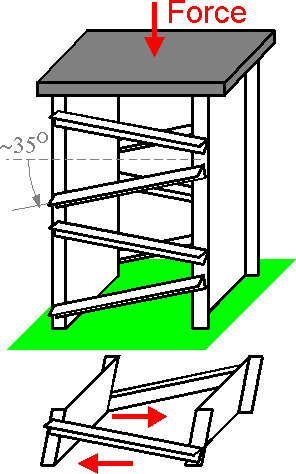 The
calculation shows that the critical force is the highest for a
structure with maximum shear rigidity. This condition corresponds to
an optimal angle 35.26 degrees. For smaller or larger angles the
shear stiffness is smaller.
The
calculation shows that the critical force is the highest for a
structure with maximum shear rigidity. This condition corresponds to
an optimal angle 35.26 degrees. For smaller or larger angles the
shear stiffness is smaller.
 The
critical stress corresponding to buckling depends on beam length and
yield properties of the material. In short columns the critical
stress can exceed the yield strength (tension).
The
critical stress corresponding to buckling depends on beam length and
yield properties of the material. In short columns the critical
stress can exceed the yield strength (tension).
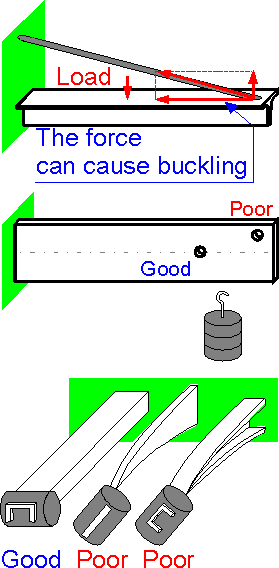 A
tensile force in the cable compresses the beam. The loading can
result in buckling of the beam.
The closer to the fixed
end, the smaller the bending moment. The closer to the neutral axis,
the smaller the torque under buckling.
The first example
of the cantilever beams demonstrates the most efficient use of the
material. The last two structures are unstable due to possible
buckling and torsion.
A
tensile force in the cable compresses the beam. The loading can
result in buckling of the beam.
The closer to the fixed
end, the smaller the bending moment. The closer to the neutral axis,
the smaller the torque under buckling.
The first example
of the cantilever beams demonstrates the most efficient use of the
material. The last two structures are unstable due to possible
buckling and torsion.
